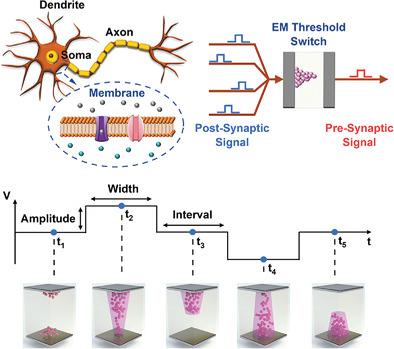当前位置:
X-MOL 学术
›
Adv. Electron. Mater.
›
论文详情
Our official English website, www.x-mol.net, welcomes your feedback! (Note: you will need to create a separate account there.)
An Artificial Neuron Using a Bipolar Electrochemical Metallization Switch and Its Enhanced Spiking Properties through Filament Confinement
Advanced Electronic Materials ( IF 6.2 ) Pub Date : 2020-11-30 , DOI: 10.1002/aelm.202000410 Taehyun Kim 1 , Seung‐Hwan Kim 2 , Jae‐Hyeun Park 2 , June Park 3 , Euyjin Park 2 , Seung‐Geun Kim 1 , Hyun‐Yong Yu 1, 2
Advanced Electronic Materials ( IF 6.2 ) Pub Date : 2020-11-30 , DOI: 10.1002/aelm.202000410 Taehyun Kim 1 , Seung‐Hwan Kim 2 , Jae‐Hyeun Park 2 , June Park 3 , Euyjin Park 2 , Seung‐Geun Kim 1 , Hyun‐Yong Yu 1, 2
Affiliation

|
Neural networks composed of artificial neurons and synapses mimicking the human nervous system have received much attention because of their promising potential in future computing systems. In particular, spiking neural networks (SNNs), which are faster and more energy‐efficient than conventional artificial neural networks, have recently been the focus of attention. However, because typical neural devices for SNNs are based on complementary metal‐oxide‐semiconductors that exhibit high consumption of power and require a large area, it is difficult to use them to implement a large‐scale network. Thus, a new structure should be developed to overcome the typical problems that have been encountered and to emulate bio‐realistic functions. This study proposes a versatile artificial neuron based on the bipolar electrochemical metallization threshold switch, which exhibits four requisite characteristics for a spiking neuron: all‐or‐nothing spiking, threshold‐driven spiking, refractory period, and strength‐modulated frequency. Furthermore, unique features such as an inhibitory postsynaptic potential and the bipolar switching characteristic for changing synaptic weight are realized. Additionally, by using a filament confinement technique, a high on/off ratio (≈6 × 107), a low threshold voltage (0.19 V), low variability (0.014), and endurance over 106 cycles are achieved. This research will serve as a stepping‐stone for advanced large‐scale neuromorphic systems.
中文翻译:

使用双极电化学金属化开关的人工神经元及其通过细丝约束增强的尖峰特性
由人工神经元和模拟人类神经系统的突触组成的神经网络由于在未来的计算系统中具有广阔的发展前景而备受关注。特别是,尖峰神经网络(SNN)比常规的人工神经网络更快,更节能,最近已成为关注的焦点。但是,由于用于SNN的典型神经设备基于互补金属氧化物半导体,它们表现出高功耗并需要大面积,因此很难使用它们来实现大规模网络。因此,应该开发一种新的结构来克服已经遇到的典型问题并模仿生物现实功能。这项研究提出了一种基于双极电化学金属化阈值开关的通用人工神经元,该神经元具有尖峰神经元的四个必要特征:全或无尖峰,阈值驱动尖峰,不应期和强度调制频率。此外,实现了独特的功能,例如抑制突触后电位和改变突触重量的双极转换特性。此外,通过使用细丝约束技术,可以实现较高的开/关比(≈6×10 实现了独特的功能,例如抑制突触后电位和改变突触重量的双极转换特性。此外,通过使用细丝约束技术,可以实现较高的开/关比(≈6×10 实现了独特的功能,例如抑制突触后电位和改变突触重量的双极转换特性。此外,通过使用细丝约束技术,可以实现较高的开/关比(≈6×10如图7所示,实现了低阈值电压(0.19 V),低可变性(0.014)和超过10 6个周期的耐久性。这项研究将成为高级大规模神经形态系统的垫脚石。
更新日期:2021-01-14
中文翻译:

使用双极电化学金属化开关的人工神经元及其通过细丝约束增强的尖峰特性
由人工神经元和模拟人类神经系统的突触组成的神经网络由于在未来的计算系统中具有广阔的发展前景而备受关注。特别是,尖峰神经网络(SNN)比常规的人工神经网络更快,更节能,最近已成为关注的焦点。但是,由于用于SNN的典型神经设备基于互补金属氧化物半导体,它们表现出高功耗并需要大面积,因此很难使用它们来实现大规模网络。因此,应该开发一种新的结构来克服已经遇到的典型问题并模仿生物现实功能。这项研究提出了一种基于双极电化学金属化阈值开关的通用人工神经元,该神经元具有尖峰神经元的四个必要特征:全或无尖峰,阈值驱动尖峰,不应期和强度调制频率。此外,实现了独特的功能,例如抑制突触后电位和改变突触重量的双极转换特性。此外,通过使用细丝约束技术,可以实现较高的开/关比(≈6×10 实现了独特的功能,例如抑制突触后电位和改变突触重量的双极转换特性。此外,通过使用细丝约束技术,可以实现较高的开/关比(≈6×10 实现了独特的功能,例如抑制突触后电位和改变突触重量的双极转换特性。此外,通过使用细丝约束技术,可以实现较高的开/关比(≈6×10如图7所示,实现了低阈值电压(0.19 V),低可变性(0.014)和超过10 6个周期的耐久性。这项研究将成为高级大规模神经形态系统的垫脚石。


























 京公网安备 11010802027423号
京公网安备 11010802027423号